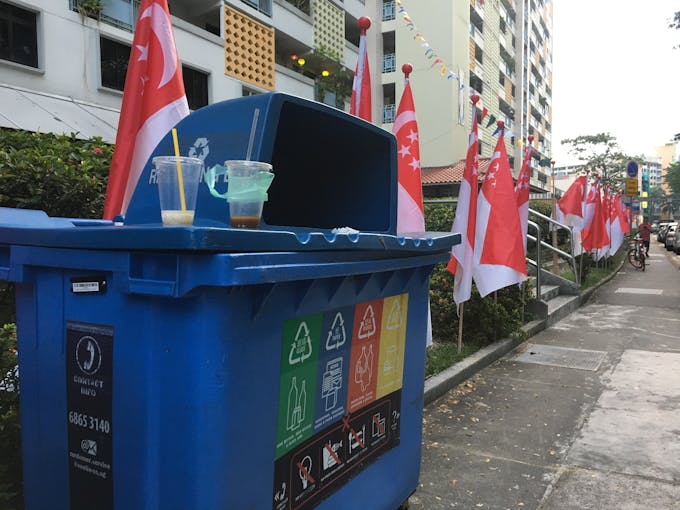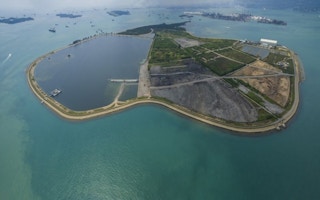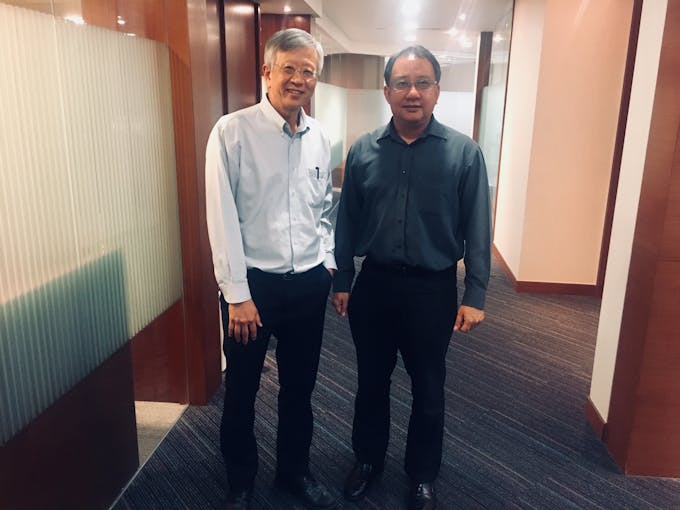Singapore is one of the world’s most efficient, liveable, and prosperous cities. But the tropical city-state is struggling in one important area—how it manages waste.
To continue reading, subscribe to Eco‑Business.
There's something for everyone. We offer a range of subscription plans.
- Access our stories and receive our Insights Weekly newsletter with the free EB Member plan.
- Unlock unlimited access to our content and archive with EB Circle.
- Publish your content with EB Premium.
The country’s streets, parks and waterways are famously clean, thanks to a well-tuned rubbish collection system that is the envy of Southeast Asia. But as the amount of waste it produces grows—solid waste generated has increased by almost two thirds in under two decades, from 4.7 million tonnes in 2000 to 7.7 million tonnes in 2018—the land-scarce island is running out of space to manage it.
Pulau Semakau, Singapore’s only landfill, is filling up rapidly, and strategies to avoid filling the site completely by 2035 as projected are not working.
The country’s domestic recycling rate has remained flat— at about 20 per cent—for more than a decade, and citizens do not know how or what to recycle; 40 per cent of items deposited for recycling cannot be recycled as it is contaminated by food or liquid. So it is incinerated.
Singapore incinerates more than 2.8 million tonnes of waste a year, up from 2.4 million tonnes in 2000. While the argument for incineration is compelling for a land-constrained island, is burning material rather than reusing or recycling it sustainable?
Even though Singapore’s incineration plants generate electricity, they are also heavy carbon emitters and choke the incentive to recycle.
“
We are not relying on waste-to-energy over the long term. Though it’s necessary infrastructure now, we will eventually move towards more sustainable waste management solutions.
Ong Soo San, director, Waste Management Infrastructure Department, National Environment Agency
But what else can Singapore do to defuse its 16-year waste time bomb? Decades of public education campaigns to encourage the 3Rs—reduce, reuse, recycle—have not moved the needle, and at the current rate of waste generation, Singapore will need another incinerator every seven to 10 years to manage.
In this interview with Eco-Business, two of the National Environment Agency’s most senior waste officials—Ong Soo San, director of Waste Management Infrastructure Department, and Ron Wong, the department’s deputy director—reveal their perspectives on Singapore’s new waste masterplan, mitigating the environmental impact of incineration, and what Singapore will do when its only landfill reaches capacity.
What was the thinking behind the government declaring 2019 the ‘Year Towards Zero Waste’?
Ron Wong: It allows us to focus on three key waste streams—food waste, packaging waste (including plastics) and electrical and electronic waste (e-waste). Most importantly, we want people to recycle right. If we’re to become a zero waste nation, we need the cooperation of businesses and residents — the government can’t do everything. At the moment, a large percentage of material found in the blue recycling bins is contaminated [so it is incinerated rather than recycled].
We’ve launched the RecycleRight campaign to show people how to recycle properly. The key message of the campaign is that there is no need for people to separate their recyclables.
They just need to put them all in the blue recycling bin and it will be sorted centrally. It’s important for people to read the label to make sure it’s recyclable, and to ensure that what they put in the blue recycling bins does not contain food or liquid.
One reason why Singapore’s domestic recycling rate is so low—22 per cent—is that residents often believe that even if they put clean items in the blue recycling bins, they’ll be dumped in with regular waste and incinerated anyway. So how will the #RecycleRight campaign address that concern?
Ron Wong: We want to inform residents about what happens to the recyclables they place in the blue recycling bins — that’s a key part of the message.
Ong Soo San: Forty per cent of what goes into recycling bins cannot be recycled, and some of that is material that it does not make economic sense to recycle or is not suitable to recycle, such as soft toys and pillows.

A blue recycling bin in the district of Tiong Bahru, Singapore. The city-state’s recycling rate has been stagnant since 2012. Image: Eco-Business
In the past, recyclables collection was done by regular refuse trucks. This gave the impression that recyclables were collected just like other types of waste and then disposed of, when actually they were sent to material recovery facilities to be sorted centrally, then recycled.
Moving forward, with the new public waste collection contracts, the appointed public waste collector responsible for recycling will do so in distinctly designed blue trucks. This is to help convey the message that the recyclables collected will actually be recycled. We want to assure residents that the efforts that they put in are not wasted.
What can we expect from Singapore’s zero waste masterplan? A tax or ban on plastic is one of the policies that some green groups locally have been advocating for.
Ron Wong: The masterplan will cover the key waste streams - e-waste, packaging waste and food waste.
Producers of packaging and packaged products will need to report and submit a 3R plan for the packaging they place in the Singapore market from 2020.
We are also studying an EPR [Extended Producer Responsibility, a policy which makes producers responsible for managing their products after consumers have used them] scheme for packaging, which will be applicable by 2025. We are working towards implementing an EPR for e-waste by 2021.
What about food waste, which makes up 10 of Singapore’s waste stream and has increased by more than 40 per cent since 2008?
Ong Soo San: We have developed a guidebook, [A Handy Guide to Reducing Food Wastage and Saving Money] to help residents reduce the food they waste at home. We are also requiring large food waste generators to segregate food waste for treatment by 2024.
Some retailers in Singapore are criticised for the amount of plastic bags they give out to customers. But retailers, for instance RedMart and BreadTalk, say that it’s a NEA food safety requirement to individually wrap food items. What do you make of this?
Ron Wong: No, it’s not NEA’s requirement. In the days before BreadTalk, individual bags were not given out for each bun. The important thing is to handle food in a safe, hygienic manner. Bread mixed with other breads in their own store shouldn’t be a problem.
With the rise of online food delivery services, the use of disposable plastic packaging is increasing quickly. What’s your view on the waste impact of online deliveries?
Ron Wong: We’ve seen some improvement from online food delivery companies [such as a system for customers to opt out of plastic cutlery by Foodpanda and Deliveroo, and a container rental service from startup Revolv, which launched in Singapore this year].
We hope to see more of these ideas from the industry, and for good practices to be shared with other companies to cut down the use of disposable plastic packaging.
What role do consumers play in pushing companies towards more sustainable practices?
Ong Soo San: We have seen a particularly strong response to our food waste reduction campaign. Everyone knows it’s morally wrong to throw away food. If consumers see a supermarket throwing away food, they’ll speak out about it.
Ron Wong: Awareness is much higher now than it was; it starts in schools with environmental programmes that we hope this will translate into action later in life.
With countries such as China, and now Malaysia and Thailand, closing their doors to waste imports, the future of recycling seems to be to do it locally. Is Singapore’s long-term ambition to be a regional hub for recycling innovation? If so, what’s the plan to expand Singapore’s expertise in recycling?
Ron Wong: There are local recycling capabilities to treat our waste. For the upcoming e-waste management system, we are adopting an EPR framework where we want producers to put in resources to be responsible for the end-of-life collection and treatment of their products.
We need to establish our own systems before we look into becoming a regional hub [for recycling], and that means establishing the EPR system for e-waste, and getting that right first.
Ong Soo San: Singapore is small—there are a lot of competing uses of land. I think Singapore is more suited to be a hub for recycling technology development, not as a hub for recycling material from other countries.
Singapore is soon to launch a fifth integrated waste-to-energy plant. How is this plant different, and what is being done to ensure that emissions—which are huge for incineration plants—are kept to a minimum?
Ong Soo San: There are very stringent pollution control measures at the waste-to-energy (WTE) plants — one third of the incineration process is devoted to flue gas treatment systems for pollution control. The flue gas goes through the electrostatic precipitators to remove 99.7 per cent of the dust. The flue gas then passes through the catalytic bag filters where the dioxin [a highly toxic pollutant and powerful carcinogen produced from burning plastic] is converted into carbon dioxide and water.
The final emissions from the plant are clean — similar to the standard adopted by incineration plants in advanced countries such as Switzerland and Germany.
But we are not relying on WTE over the long term. Though it’s necessary infrastructure now, we will eventually move towards more sustainable waste management solutions as we strive towards becoming a zero waste nation. New incineration plants will replace older ones that need to be decommissioned eventually.
Has the NEA done any studies on incidences of illness among residents living near the incineration plants in Tuas?
Ong Soo San: Our incineration plants in Tuas are sited away from residential developments, and there’s a buffer area [separating the plants from residents].
Ron Wong: There are examples where incineration plants are sited near residential areas in other countries. In Cophenhagen, Denmark, the new Amager Bakke incineration plant was built near a residential development to generate electricity and supply heat to the district heating network. The plant also has a ski slope on its roof.
Ong Soo San: It also provide district heating to the residents. In our case, we’ve located them (IPs) in the industrial district as we do not need district heating, and the electricity they generate feeds to the main grid.
Tell us about the new mega incineration plant in Tuas, which will integrate water management with waste to energy.
Ong Soo San: Building a new plant means that we’ll be able to replace the older, less efficient plants, and help to reduce the carbon footprint as well. The same amount of waste can produce double the amount of energy.
The reason why we co-located [the new plant at Tuas] with the used water reclamation facility is the synergy that we can get when we combine them for better efficiency and resource recovery. The food waste collected can also be co-digested with used water sludge from wastewater. That will help increase the amount of biogas produced, and in turn the amount of electricity generated.
To keep incineration plants going, you need more waste to fuel them, which has the effect of putting the circular economy into reverse, doesn’t it?
Ong Soo San: Singapore’s first and key strategy is waste reduction. Second is to recycle what we can’t reduce. The third strategy is waste-to-energy, to reduce the volume of waste, and the ash is sent to the landfill.
The next thing that we are focusing on is how to re-use the incineration ash, and to turn it into sand—called NEWSand—for construction purposes, thereby closing the waste loop.
The uses of NEWSand could be interesting. There’s a lot of talk of using plastic waste for roads, is that what it will be used for?
Ong Soo San: The incineration bottom ash can be potentially used for non-structural purposes. The incineration bottom ash has to be treated to ensure that it is suitable for construction purposes. Firstly, the metals from the ash have to be extracted. We extract more than 200 tonnes of metal a day from the incinerated bottom ash. We are currently exploring treatment process to render the ash for compliance with the environmental standards for construction application. By reusing the incinerated bottom ash, the demand for landfill space will be reduced and the lifespan of Semakau Landfill extended.
But will the construction industry, and people living and working in the buildings it constructs, want a building material made from toxic waste?
Ron Wong: We need to firstly establish the standards for the use of incineration bottom ash. To do so, we have to consult all the relevant agencies on their concerns, and to incorporate the standards that will eventually be suitable for use in Singapore.
Ong Soo San: Right now we are developing the environmental standards and testing some treatment technology to see how it can meet the standards. This is still a work in progress.
There’s been a lot of concern over what will happen once Semakau, Singapore’s man-made trash island recently popularised by a viral video by blogger Nuseir Yassin, is full—which is expected to happen by 2035 or earlier. Does Singapore have another island in store ready once Semakau is full?
Ron Wong: We want to prolong the lifespan of Semakau Landfill for as long as possible, which is why we embarked on the 3R [reduce, reuse, recycle] approach. The last part is looking at how we can develop standards for the use of incineration bottom ash.
But what about after Semakau has filled up—what then?
Ron Wong: There are a lot of competing uses for land and sea in Singapore…
Ong Soo San: Sea space may be even more limited than land space, because of the needs of the shipping industry [Singapore is the world’s second largest container port]. Hence, there is a need to extend the life of our only landfill site.
Which other countries do you consider good at managing waste that Singapore can learn from?
Ron Wong: We do keep track of the waste management developments in other countries and learn from them. For example, The Netherlands, which is also a country with space constraints, and uses incineration to manage waste.
A good example of this is the AEB waste-to-energy plant in Amsterdam [the world’s largest, which converts 1.4 million tonnes of waste into enough electricity to power 320,000 households, and produces metals from the waste such as iron, copper and aluminium, and fill material for the construction industry]. Incineration bottom ash is also used in The Netherlands.
What about countries in Asia, such as Japan, which has strong Extended Producer Responsibility laws in place?
Ron Wong: The key countries we often reference are South Korea and Japan.
Ong Soo San: For example, in the area of waste to energy, Japan has a few hundred incineration plants, where each prefecture and municipality has responsibility for its own waste. They can’t build a big plant to get the economies of scale, as we have done in Singapore. Even though Japan has an EPR law in place, we cannot adopt another country’s policy wholesale. Singapore’s scenario is unique. We have to look at our own waste landscape and adopt our own system.
What can other countries learn from Singapore’s waste story?
Ong Soo San: One area is construction waste. Singapore is resource constrained, so it is imperative for the industry to look at how to close the loop and reuse as much material as we can. For every demolition project, the waste material is tracked and recycled. As such, Singapore recycles 99 per cent of our construction waste.
You have one waste-related wish for 2019 — what is it?
Ong Soo San: To get the building blocks right for the EPR system for e-waste.
Ron Wong: I’d like to see Singapore residents only buy, order and use what they need, reduce waste and get into the habit of bringing reusable bags and bottles when they go shopping. And for more people to recycle right.












